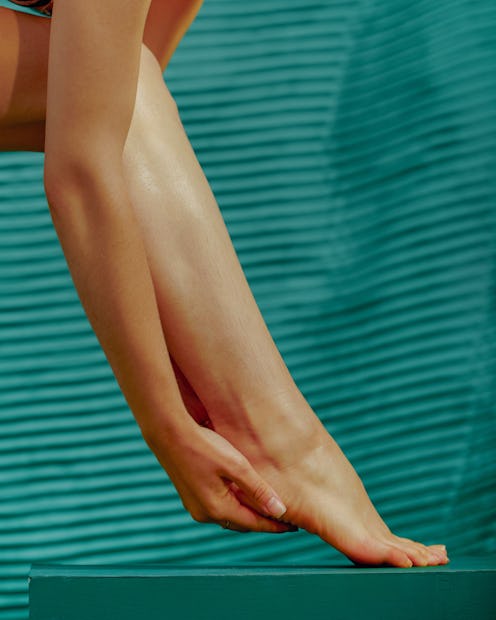(Skin)
Is Your Shaving Routine Giving You Strawberry Legs? Here’s How To Help
Pesky dots, begone.

When thinking about all the food items skin has been compared to (read: mochi and chicken skin), the term strawberry legs won’t come as a surprise. If you’ve ever glanced down at your legs only to be met with a cluster of tiny, discolored dots scouring the surface of your skin, you may be one of many dealing with the condition. Strawberry legs itself is more of a nuisance than cause for concern, and has a number of causes and (thankfully) treatments that can help minimize their appearance. As board-certified dermatologist and Mohs surgeon Dr. Tiffany Libby explains, the term refers to small dark spots that appear when follicles or pores get clogged. They’re called strawberry legs because “they can resemble the pitted surface of a strawberry,” says Dr. Libby.
Technically, strawberry legs are open comedones that are clogged with oil, dirt, and debris. When they become oxidized (a.k.a they’re exposed to air), they take on a darkened look, and “when you have many of these appearing in the same area, they can give the appearance of the pitted, seeded surface of a strawberry,” says Dr. Libby. To get rid of strawberry legs, you’ll have to get to the source of those clogged follicles.
Below, find out everything you need to know about what’s causing these dots, as well as how to treat and prevent them.
What Causes Strawberry Legs?
The main culprit of strawberry legs? Shaving. New York City-based board-certified dermatologist Dr. Hadley King says that strawberry legs goes hand in hand with razor burn and ingrown hairs, both of which occur as a result of using an old, dull razor or shaving sans shaving cream. In extreme cases, poor shaving habits that lead to razor burn can also lead to folliculitis, an infection of the hair follicles that causes redness and bumpiness at the hair follicle and can leave behind residual scarring and hyperpigmentation, Dr. Libby tells TZR. (Remember, strawberry legs shouldn’t come with any life-altering side effects, so if you’re experiencing itching or pain, you may want to pay a visit to your derm to rule out folliculitis.)
Another factor that can lead to strawberry legs is keratosis pilaris, or KP for short. This skin condition is hereditary, says Dr. Audrey Kunin, board-certified dermatologist and founder of Dermadoctor, and shows up when there’s a buildup of skin cells around the hair follicles. You’ll know you’re dealing with KP if the texture of your skin is dry, rough, and bumpy — the dots will also have a pigment to them. “On fair skin, it appears as pink or red polka dots while those with deeper skin tones may find they appear as brown or black spots,” notes Dr. Kunin.
Finally, dry skin could be to blame. Though it’s not usually the case that dry skin on its own causes strawberry legs, if your skin is dehydrated as a result of poor shaving habits (like shaving with just water), this can contribute to those small dark dots. And, as Dr. Michele Farber of Schweiger Dermatology Group says, not only can pores appear more prominent when dry, but dry skin can also exacerbate other conditions like keratosis pilaris. Bottom line: stay on top of your skin’s hydration game.
How To Prevent Strawberry Legs
First step in kicking strawberry legs to the curb: exfoliation. “Exfoliation helps dissolve surface skin cells that clog pores, and can help improve the texture of skin,” notes Dr. Libby, who recommends ingredients like lactic acid, glycolic acid, and salicylic acid to exfoliate the skin on a deeper level. “Benzoyl peroxide is another ingredient to look out for — not only is it [exfoliating], but it’s anti-bacterial and can prevent folliculitis,” says Dr. Libby.
It also helps to switch out your razor regularly. “Having good shaving hygiene by using a new, glide-strip razor and shaving cream can help protect the skin when shaving,” says Dr. Farber. Not to mention, using a sharp razor also makes nicks and cuts less likely. Top off your shaving routine with a hefty dose of moisturizer — Dr. Libby says to scout hydrating ingredients like glycerin, hyaluronic acid, ceramides, and colloidal oatmeal to help strengthen and support the skin barrier.
Ready to tackle strawberry legs head-on? Here are a few picks that’ll lend you a helping hand.
We may receive a portion of sales if you purchase a product through a link in this article.
This article was originally published on